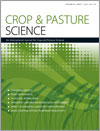Improved dryland pastures for sheep and beef cattle production in south-western Victoria are typically based on summer-dormant cultivars of perennial ryegrass (Lolium perenne L.) or phalaris (Phalaris aquatica L.). These are highly productive in spring but exhibit low accumulation rates over summer–autumn. Summer-active perennial pasture species could potentially alleviate this summer–autumn feed gap.
Three pasture systems that used different pastures on each of the three landscape classes (crest, slope, and valley floor) were compared over 4 years. The perennial ryegrass system (henceforth Ryegrass) had a different ryegrass cultivar on each landscape class. The Triple system used lucerne (Medicago sativa L.) (crest), perennial ryegrass (slope), and summer-active tall fescue (Lolium arundinaceum (Schreb) Darbysh.) (valley floor). The Novel system used chicory (Cichorium intybus L.) (crest), Italian ryegrass (Lolium multiflorum Lam.) or hybrid ryegrass (L. × boucheanum Kunth.) (slope), and kikuyu (Pennisetum clandestinum Hochst. ex Chiov.) (valley floor). The pastures were grazed by either one (in the case of the Novel system) or three (in the case of the Ryegrass and Triple systems) animal systems that varied over the life of the experiment.
Total annual herbage accumulation of the Ryegrass and Triple systems did not differ. The Novel system consistently had lower total annual dry matter accumulation than the other two systems. Lucerne pastures generally had the highest accumulation rates over summer, followed by the chicory pastures. The kikuyu pastures responded well to summer rainfall but otherwise had similar accumulation rates to the perennial ryegrass and tall fescue pastures over summer. Tall fescue pastures grew well in autumn following wet summers. In spring the perennial ryegrass pastures based on Fitzroy or Avalon were highly productive but seldom grew faster than other pastures.
The results support the hypothesis that incorporating deep-rooted, summer-active perennial species will increase pasture production over summer–autumn compared with conventional pasture systems but not at the expense of winter–spring production.





